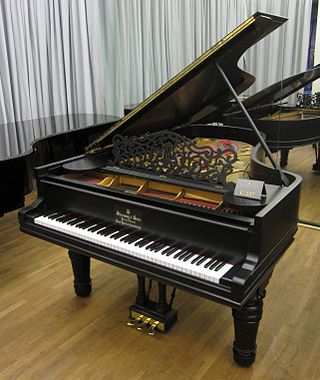
The piano is a keyboard instrument that produces sound when pressed on the keys. Most modern pianos have a row of 88 black and white keys: 52 white keys for the notes of the C major scale and 36 shorter black keys raised above the white keys and set further back, for sharps and flats. This means that the piano can play 88 different pitches, spanning a range of a bit over seven octaves. The black keys are for the "accidentals", which are needed to play in all twelve keys.
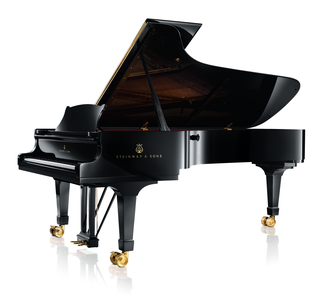
Steinway & Sons, also known as Steinway, is a German-American piano company, founded in 1853 in Manhattan by German piano builder Heinrich Engelhard Steinweg. The company's growth led to the opening of a factory in New York City, United States, and later a factory in Hamburg, Germany. The factory in the Queens borough of New York City supplies the Americas, and the factory in Hamburg supplies the rest of the world.

The National Music Museum: America's Shrine to Music & Center for Study of the History of Musical Instruments (NMM) is a musical instrument museum in Vermillion, South Dakota, United States. It was founded in 1973 on the campus of the University of South Dakota. The NMM is recognized as "A Landmark of American Music" by the National Music Council.
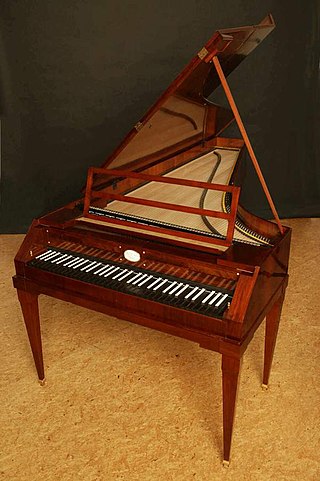
A fortepiano, sometimes referred to as a pianoforte, is an early piano. In principle, the word "fortepiano" can designate any piano dating from the invention of the instrument by Bartolomeo Cristofori in 1698 up to the early 19th century. Most typically, however, it is used to refer to the mid-18th to early-19th century instruments, for which composers of the Classical era, especially Haydn, Mozart, and the younger Beethoven and Hummel, wrote their piano music.
Kawai Musical Instruments Manufacturing Co., Ltd. is a musical instrument manufacturing company headquartered in Hamamatsu, Shizuoka, Japan. It is best known for its grand pianos, upright pianos, digital pianos, electronic keyboards and electronic synthesizers. The company was founded in August 1927.
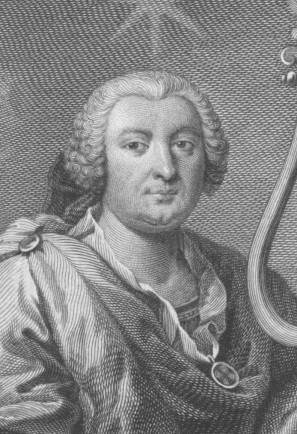
José António Carlos de Seixas was a pre-eminent Portuguese composer of the 18th century. An accomplished virtuoso of both the organ and the harpsichord, Seixas succeeded his father as the organist for Coimbra Cathedral at the age of fourteen. In 1720, he departed for the capital, Lisbon, where he was to serve as the organist for the royal chapel, one of the highest offices for a musician in Portugal, a position which earned him a knighthood. Much of Seixas' music rests in an ambiguous transitional period from the learned style of the 17th century to the galant style of the 18th century.

Johann (Georg) Andreas Stein was an outstanding German maker of keyboard instruments, a central figure in the history of the piano. He was primarily responsible for the design of the so-called German hammer action. Pianos with this hammer action, or its more developed form known as the Viennese action, may be said to be appropriate for the performance of the piano music of Haydn, Mozart, and the early works of Beethoven and Schubert.

John Broadwood & Sons is an English piano manufacturer, founded in 1728 by Burkat Shudi and continued after his death in 1773 by John Broadwood.

The square piano is a type of piano that has horizontal strings arranged diagonally across the rectangular case above the hammers and with the keyboard set in the long side, with the sounding board above a cavity in the short side. It is variously attributed to Silbermann and Frederici and was improved by Petzold and Babcock. The English and Viennese square pianos were built in many different designs, including within the action as well as general appearance, from roughly 1760. Because of the competitive industry and relative youth of the instrument design itself, experimentation ensued in the early years, creating a range of moderators and other technical devices not seen today.

Piano pedals are foot-operated levers at the base of a piano that change the instrument's sound in various ways. Modern pianos usually have three pedals, from left to right, the soft pedal, the sostenuto pedal, and the sustaining pedal. Some pianos omit the sostenuto pedal, or have a middle pedal with a different purpose such as a muting function also known as silent piano.
The Kirkman family were English harpsichord and later piano makers of Alsatian origin, active from the 1750s until the late 1800s.
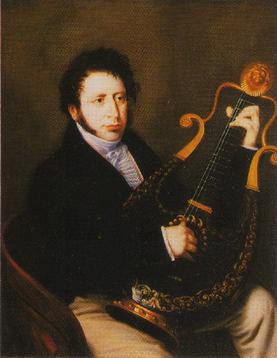
Robert Wornum (1780–1852) was a piano maker working in London during the first half of the 19th century. He is best known for introducing small cottage and oblique uprights and an action considered to be the predecessor of the modern upright action which was used in Europe through the early 20th century. His piano manufacturing business eventually became Robert Wornum & Sons and continued half a century after his death.

Gabriel Anton Walter was a builder of pianos. The Grove Dictionary of Music and Musicians describes him as "the most famous Viennese piano maker of his time".

The Berlin Musical Instrument Museum is located at the Kulturforum on Tiergartenstraße in Berlin, Germany. The museum holds over 3,500 musical instruments from the 16th century onward and is one of the largest and most representative musical instrument collections in Germany. Objects include a portable harpsichord once owned by Prussia's Queen Sophie Charlotte, flutes from the collection of Frederick the Great, and Benjamin Franklin's glass harmonica.
The Colt Clavier Collection was a collection of historical keyboard instruments located in Bethersden, Kent, England. Consisting mostly of 18th and 19th-century pianos, it also included a few harpsichords and a few unusual keyboards which defy standard categorisation. It was thought one of the most important collections of historically important keyboard instruments in the world. Some 114 instruments, the balance of the collection, were sold on 7 June 2018 by Canterbury Auction Galleries.

Music technology is the study or the use of any device, mechanism, machine or tool by a musician or composer to make or perform music; to compose, notate, playback or record songs or pieces; or to analyze or edit music.
The Antunes family were Portuguese harpsichord- and early piano builders in the 18th and 19th centuries.
Johann Peter Fritz was a piano maker based in Vienna. He was one of Vienna's most distinguished piano makers. His pianos were valued for good quality and melodiousness. It is known, that Giuseppe Verdi was very fond of Johann Fritz's pianos and used the Viennese 6-pedal Fritz piano from the time of Rigoletto in 1851 to Aida in 1871. This exact piano can be seen in the composer's Villa Verdi in Province of Piacenza in Italy.

















